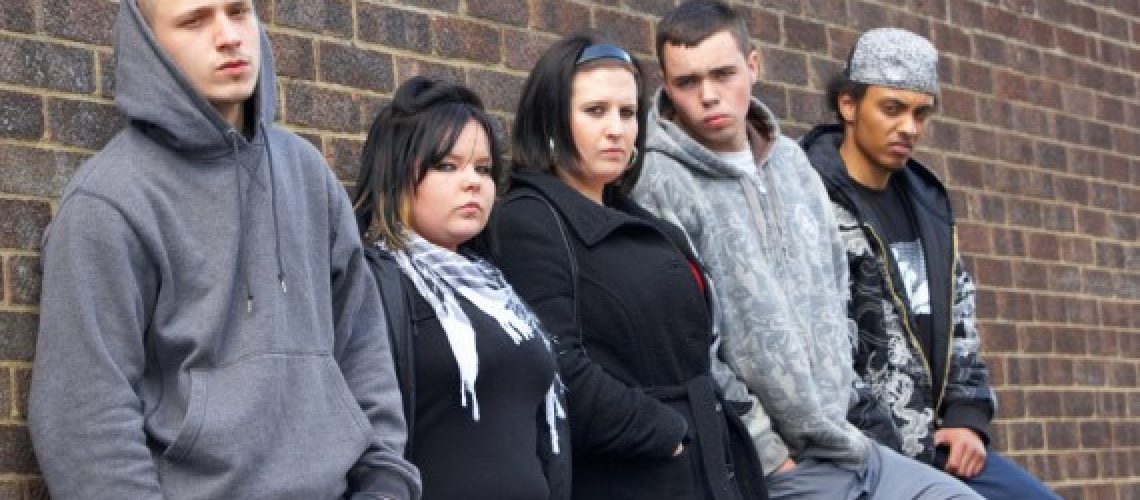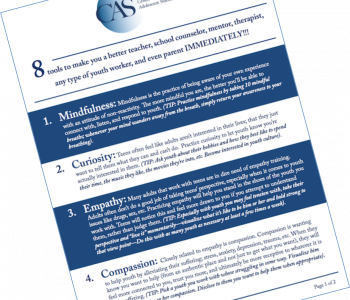

Sam Himelstein, PhD
Sam Himelstein is the founder and CEO of the Center for Adolescent Studies, Inc. He is passionate about working with youth and training the professionals that serve them.
A Critical Intervention For Working With Traumatized Youth
Working with youth who’ve experience trauma in their lives can be both a challenging and rewarding endeavor and of course, is a multifaceted process absent of a “one size fits all” approach. One of the questions I often get in my trainings and at conferences is what to actually do when a youth struggling with trauma gets highly triggered. These are the times when a youth has a sudden aggressive outburst, or becomes detached and completely checks out, or in some way becomes so activated that they cannot or will not function within the normal bounds of their behavior and most likely (at least for aggressive youth) will make you very uncomfortable in the process. I have therapists, educators, probation professionals, mentors, and other youth professionals ask: “What can I do in those moments?”
Oftentimes people are interested in the newest mindfulness technique, the therapy technique with the most evidence supporting its efficacy for dealing with triggered youth, and so on. The truth is, and it’s difficult for some to be receptive to this viewpoint, that human experience is so nuanced that many “techniques” can be effective for some youth but not others; in some situations and not others. I find myself often saying, “it depends” and apologizing to individuals in my trainings who want more concrete answers.
However, one gem I’ve found useful in calming youth down into the window of tolerance (i.e., an internal somatic state where the nervous system is activated but bearable for the individual; more on this in another post) so that they can then be receptive to other interventions, is what I like to call an INCRA; Inherently Non-Clinical Relational Activity.
What is an INCRA?
An inherently non-clinical relational activity is any relational activity that is inherently not a therapy technique but fosters the relationship. For example, coloring, drawing, playing cards, playing sports, going for a walk, listening to music, playing chess, etc. are all inherently non-clinical. They all also, however can be used as great clinical tools to build rapport, help an individual get comfortable talking with you, and be used to help triggered individuals focus on another activity while calming down. Personally, I play a lot of cards and listen to a lot of music with youth. I have countless youth enter my office and when I ask what’s on their minds or if they wanted to talk about anything in particular in the session they’d say “I don’t really have anything to talk about.” When we start playing cards, they stop thinking of the pressure of therapy and next thing I know I know everything about their life story! That’s the value of an INCRA, it gets you and the youth you work with relating to one another and building comfort.
Why an INCRA for a Triggered Youth?
For those of us that have worked with highly traumatized youth, we know that we have to have a strong relationship and their trust in order for them to be receptive to our interventions (e.g., getting them to do a breathing technique to better manage anger). Especially for traumatized youth who are triggered, we know how the prefrontal cortex at times gets disconnected communicatively from the rest of the brain and it’s extremely difficult for youth to think logically. When this happens it’s difficult to respond to questions, take direction, or learn new information. Their bodies take over (see an over view of trauma and the brain here).
In such moments, if not receptive to an intervention we present (and we can tell because it’s probably hard for them to listen, talk, or possibly even think normally), it’s best to engage in an INCRA so that the nervous system begins to regulate itself.
The first step to get traumatized youth to calm down is to foster a sense of safety.
An INCRA has the potential to do so. It also focuses their mind on something else even if in part (e.g., the music, the cards, etc.). An INCRA is also a great entry point to more clinical interventions that have the potential to really calm down youth and begin the healing process with other intervention.
Case Example
I once worked with a young man at the juvenile hall who had an abundant history of trauma; including community violence, family deaths, and assaults against him. He was angry most of the time and self-described himself as having a “short fuse.” One day he found out a close relative died and was so triggered he could barely talk. The staff was afraid they’d have to restrain him because he might refuse to go to his room or because he might hurt another youth.
I was able to get him to follow me into my office. He could barely talk, couldn’t/didn’t respond to my questions, and simply had an aggressive stare on his face (a sign that he was above the threshold of the window of tolerance and completely triggered). Instead of trying the long list of clinical interventions I had learned over the years (which I pretty much knew wouldn’t work given his state), I simply asked him if he was okay listening to some music with me. He ever so slightly nodded and I pulled up a playlist. After a song or two, I asked him if there was anything he wanted to listen to. I looked up a song online that he liked. We listened to it, then another and another (we will expand on the value of a music INCRA in a future post). Something interesting started to happen; as he was listening to the music he liked, he started bobbing his head following along with the rhythm and beat of the song. I noticed his face started to relax slightly. After another song it relaxed even more. After about 4-5 songs his emotional presentation was still anger but much less extreme. The rhythmic movements he was naturally doing started helping his nervous system self-regulate itself. We started talking and he was even able to express to me the sadness he felt under his anger about his relative’s death. After that he was even open to a mindful breathing technique, which we practiced for about 3 minutes. By the end of the session, he was still angry, but had identified other emotions that contributed to his experience and could hold a conversation with me.
And all of the above was heavily influenced by the initial INCRA (listening to music) that I attempted with him. He probably wouldn’t have been open to meditating or talking right when he came into the office because he was too triggered. While an INCRA isn’t always going to work, there’s a much better chance of it being successful as an entry-point intervention when someone is in a highly triggered state. I invite you to get creative in thinking of different INCRAs you can implement and practice in your context with youth (therapy, mentoring, education, etc.).

